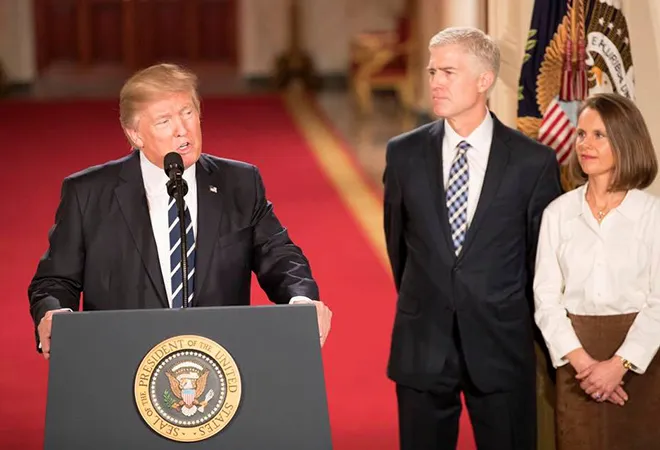As the new Trump administration tries to get a grip on multiple domestic and foreign policy obstacles facing America, China's rise will be the most significant challenge facing Washington.
Trump will be doing what his successor too tried to do in managing Asia's rapid ascendance in global hierarchy.
Notwithstanding popular perceptions of its relative decline, American response to the global transition of power has not been one of a mute spectator.
Since 2008, the year when financial crisis hit Washington, it has attempted various strategies to contain its relative decline.
Two strategies warrant a detailed discussion: its effort to form a great power condominium with China, popularly known as the 'G-2', and its attempt to confront its great power rival, evident in the strategy of pivot.
The idea of G-2 first came to prominence when American economist Fred Bergsten proposed that being the two largest economies of the world, US and China should jointly manage the global financial space.
As the US economy slumped, this idea caught the imagination of American economists who saw in it a way to sort out America's financial problems.
The G-2 talk gained currency just after Barack Obama came to the White House.
Strategy
However, many strategic thinkers like Zbigniew Brzezinski, Henry Kissinger and Niall Ferguson also saw in G-2 a strategy to manage the US decline, providing economics a 'geo-political twist'.
In the history of international politics, accommodation of a rising giant is often a strategy through which extant powers manage challenges to their hegemony.
Read Also | < style="color: #960f0f">The world system going through a serious churn
A G-2 is a classical accommodative strategy in so far it would allow the US to avoid any direct confrontation with China while holding on to its superpower status.
During Obama's early years in power, the US did make an attempt to form a close strategic partnership with Beijing.
If Hillary Clinton proclaimed that America's relationship with Beijing is the 'most important bilateral relationship in the world this century', Obama declared that 'relationship between US and China will shape the 21st century'.
From the global economy to climate change and regional issues such as North Korea and Afghanistan, the US and China were perceived to co-ordinate their policies at the expense of other states.
In parts of Asia, this strategy raised both concerns and fears of strategic abandonment by a declining America, leaving Asian states to fend for themselves under Beijing's looming hegemony.
From global economy to climate change, the US preferred talking to China bilaterally.
President Obama's first overseas trip to Beijing in November 2009 further strengthened this impulse.
Read Also | < style="color: #960f0f">What Obama has wrought
However, noises within the political and policy circles were critical of this grand accommodation with China.
These criticisms focused on China's increasing capabilities and its uncertain intentions. The series of confrontations in the East and South China Sea sent a message that, if left unchecked, the margins for smaller Asian states to satisfactorily negotiate these disputes with Beijing would only decrease.
They also supported a perception in the US that a rising China may jeopardise its basic commitments in the region.
This was the strategic context in which the strategy of 'pivot' was announced in late 2011.
It represents a simultaneous attempt to warn China away from using heavy handed tactics against its neighbours and provide confidence to other Asia-Pacific countries that want to resist pressure from Beijing.
Two elements defined the new US strategy: the reallocation of US military resources to Asia, and cultivation of strategic partners in the region.
Siege
But in the face of resource crunch at home and a series of problems in the Middle East and Europe, the results of Obama administration's 'pivot' to Asia were lacklustre. And America's pre-eminence in the region is under siege.
The Trump administration is also focused on the domestic front, though it has taken a consistently rigid position vis-à-vis China.
And South China Sea dispute is once again at the centre of the US-China spat.
Even before Trump, things were getting hotter in the South China Sea. US energy giant Exxon Mobil and state-owned Petro-Vietnam have recently agreed to develop Vietnam's largest natural gas-fired power generation project, a $10 billion joint venture known as 'Blue Whale'.
Project
This project is likely to come online in 2023 and will draw on a natural gas field situated 88 km from Vietnam's central Quang Nam province in the South China Sea.
Though the deepwater field lies within Vietnam's exclusive economic zone (EEZ), it is also in an area China claims on its nine-dash map, which lays wide-ranging claim to 90 per cent of the entire South China Sea.
And China can certainly retaliate by becoming less cooperative with the US on issues such as North Korea and more aggressive in the South China Sea and Taiwan Straits.
This commentary was first published in Daily Mail.
The views expressed above belong to the author(s). ORF research and analyses now available on Telegram! Click here to access our curated content — blogs, longforms and interviews.




 PREV
PREV


